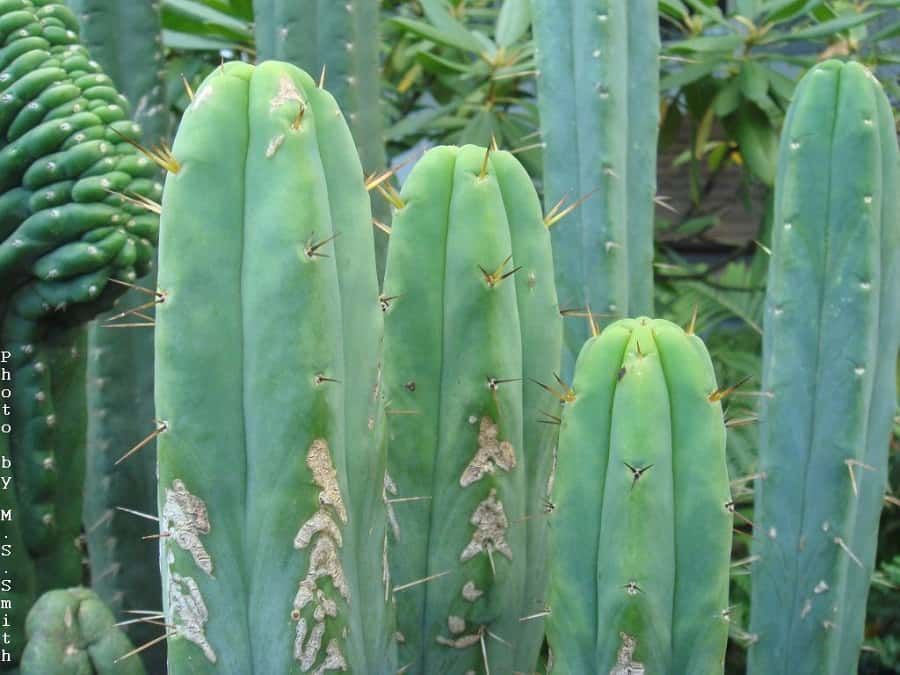The Trichocereus bridgesii cactus grows fast; some species reach impressive heights producing gorgeous flowers.
The only problem they have is that they are no longer called Trichocereus, but Echinopsis lageniformis.
The Trichocereus or Echinopsis is native to South America.
The genus is made up of about 150 species that grow between 10 centimeters and 5-6 meters high.
They are characterized by having thick stems composed of several well visible ribs.
It has very beautiful flowers, with many colors: pink, white or red. They have the peculiarity of opening at night and in the morning.
They bloom in spring or summer, depending on the mild climate.
Trichocereus bridgesii is a fast-growing plant.
It can reach 2 to 5 m in height, with stems up to 15 to 20 cm in diameter.
The ribs are obtuse, separated by wide but shallow intervals.
Its areolas are large, evenly spaced at the ribs, about 2-3 cm apart.
This plant makes light roots; therefore, it is very easy to remove and replace with another plant over time because it does not create abundant roots or poses a risk to other species.
This cactus is also recommended for indoors.
You may like: Callisia repens
Trichocereus bridgesii ‘Echinopsis lageniformis’ Care:
Substrate:
The common characteristics of all cacti are loose soils or substrates, with a slightly acidic pH, good drainage, with organic matter.
This type of plant, which develops shallow roots, is very sensitive to excess water, so you must avoid clay substrates or excessively retain moisture.
Illumination:
Trichocereus bridgesii (Echinopsis lageniformis) They are plants that have to be outdoors, in full sun.
If you want to place your succulent indoors, just make sure it’s close to a window where it can receive sunlight.
But, excessive exposure to the sun can also be harmful if you notice that the cactus turns yellowish or begins to blanch; you should locate it in an area with less light exposure.
Temperature:
It supports a high range of temperatures, even cold ones, much better than other family species.
However, it is not recommended to grow it in areas where average winter temperatures are below 5 ºC/41°F.
During winter, be careful with the heater, since temperatures of 20°C/68°F would prevent winter rest from occurring.
Watering:
In early spring, when the risk of frost disappears, and the plant begins to sprout, it is time to water with some frequency (once every 10 to 12 days).
The frequency can increase until reaching the warmer months, in which it’s watered every 2 to 3 times a week, depending on the area.
In fall, the watering intensity will begin to decrease, taking place every 8 to 10 days and spacing it more and more to bring plants to rest, until watering is almost suppressed during December and January.
At best, it could be gently watered every 20 to 40 days in the coldest period. With temperatures below 10ºC/50°F, it is not recommended to water the cacti because they rot.
Fertilizer:
Ideally, the best fertilizer should have nitrogen, potassium, and phosphorus.
Fertilize your Trichocereus bridgesii ‘Echinopsis lageniformis’ in spring and summer every two weeks. During fall and winter, you should not add fertilizer to your cactus.
Propagation:
Trichocereus bridgesii multiplies by seed, and some by stem cuttings, in spring and early summer. Let’s proceed:
Seeds
Fill a pot with universal growing medium mixed with perlite.
Then we water consciously.
Now place the seeds on the surface of the substrate.
Next, cover them with a thin layer of previously washed river sand or another type of similar sand.
Finally, spray the surface with water, and put the pot outside, in half shade.
You have to keep the substrate moist – not waterlogged – they will germinate in about two weeks.
Cuttings
To multiply by cuttings, you have to cut a piece of at least 10 cm with a knife.
It is important to let the wound dry for 3 to 6 days. After that time, you can plant the cutting in a pot with sandy soil.
From about 3 to 4 weeks, the cutting will begin to emit roots.
Transplant:
If the plant stops growing, gets a bad color or roots come out of the drainage holes, it means that it needs to be transplanted.
The new pot has to be at least 2 to 3 cm bigger than the plant.
Avoid using plastic pots, since these when heated, can overheat the roots, until they burn.
You must remove the plant from the old pot very carefully (never pull ) to avoid breaking the plant’s roots.
The new pot must have good drainage and ventilation.
It is best to fill the pot with the substrate halfway, then carefully introduce the plant. Then you must fill the pot and cover the roots completely.
The best time to transplant is spring.
It’s not recommended to water 3 to 6 days after the transplant, to allow the wounds that may have occurred during the transplant to heal.
Plagues and diseases:
Like many others, this cactus is given to suffer fungal diseases, which is caused by overwatering.
Pruning:
It does not need pruning.
